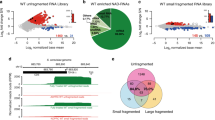Abstract
We have tested the functioning of the human c-myc polyadenylation signal in Saccharomyces cerevisiae. A DNA fragment containing the two AATAAA polyadenylation signals of the c-myc gene was inserted into a plasmid designed for the in-vivo testing of polyadenylation signals in yeast. The c-myc fragment had a partial capacity for directing mRNA 3′-end formation in yeast. The 3′-endpoints were 50–100 bp distant from the mRNA 3′-ends mapped in humans. This human DNA fragment is therefore unspecifically functional in yeast, indicating that other sequence elements than the human polyadenylation signal, AATAAA, are necessary for 3′-end formation.
Similar content being viewed by others
References
Ammerer G (1983) Methods Enzymol 101:192–201
Ar-Rushdi A Nishikura K, Erikson J, Watt R, Rovera G, Croce CM (1983) Science 222:390–393
Aviv H, Leder P (1972) Proc Natl Acad Sci USA 69:1408–1412
Birnstiel ML, Busslinger M, Strub K (1985) Cell 41:349–359
Braus G (1991) Microbiol Rev 55:349–370
Braus G, Furter R, Prantl F, Niederberger P, Hütter R (1985) Arch Microbiol 142:383–388
Butler JS, Platt T (1988) Science 242:1270–1274
Butler JS, Sadhale PP, Platt T (1990) Mol Cell Biol 10:2599–2605
Colby WW, Chen EY, Smith DH, Levinson AD (1983) Nature 301:722–725
Furter G, Paravicini G, Aebi M, Braus G, Prantl F, Niederberger P, Hütter R (1986) Nucleic Acids Res 14:6357–6373
Gazin C, Dupont de Dinechin S, Hampe A, Masson J-M, Martin P, Stehelin C, Galibert F (1984) EMBO J 3:383–387
Humphrey T, Sadhale P, Platt T, Proudfoot N (1991) EMBO J 10:3503–3511
Hunt AG, Chu NM, Odell JT, Nagy F, Chua N-H (1987) Plant Mol Biol 8:23–35
Irniger S, Egli CM, Braus GH (1991) Mol Cell Biol 11:3060–3069
Irniger S Sanfaçon H, Egli CM, Braus GH (1992) Mol Cell Biol 12:2322–2330
Ito H, Fukuda Y, Murata K, Kimura A (1983) J Bacteriol 153:163–168
Miozzari G, Niederberger P, Hütter R (1978) J Bacteriol 134:48–59
Osborne BI, Guarente L (1989) Proc Natl Acad Sci USA 86:4097–4101
Proudfoot NJ (1989) Trends Biochem Sci 14:105–110
Proudfoot N (1991) Cell 64:671–674
Russo P, Li W-Z, Hampsey DM, Zaret KS, Sherman F (1991) EMBO J 10:563–571
Russo P, Sherman F (1989) Proc Natl Acad Sci USA 86:8348–8352
Sharp PA (1987) Science 235:766–771
Suothern EM (1975) J Mol Biol 98:503–517
Struhl K (1987) Cell 49:295–297
Wickens M (1990) Trends Biochem Sci 15:277–281
Zaret KS, Sherman F (1982) Cell 28:563–573
Author information
Authors and Affiliations
Additional information
Communicated by A. Hinnen
Rights and permissions
About this article
Cite this article
Irniger, S., Egli, C.M. & Braus, G.H. Messenger RNA 3′-end formation of a DNA fragment from the human c-myc 3′-end region in Saccharomyces cerevisiae . Curr Genet 23, 201–204 (1993). https://doi.org/10.1007/BF00351496
Received:
Issue Date:
DOI: https://doi.org/10.1007/BF00351496




